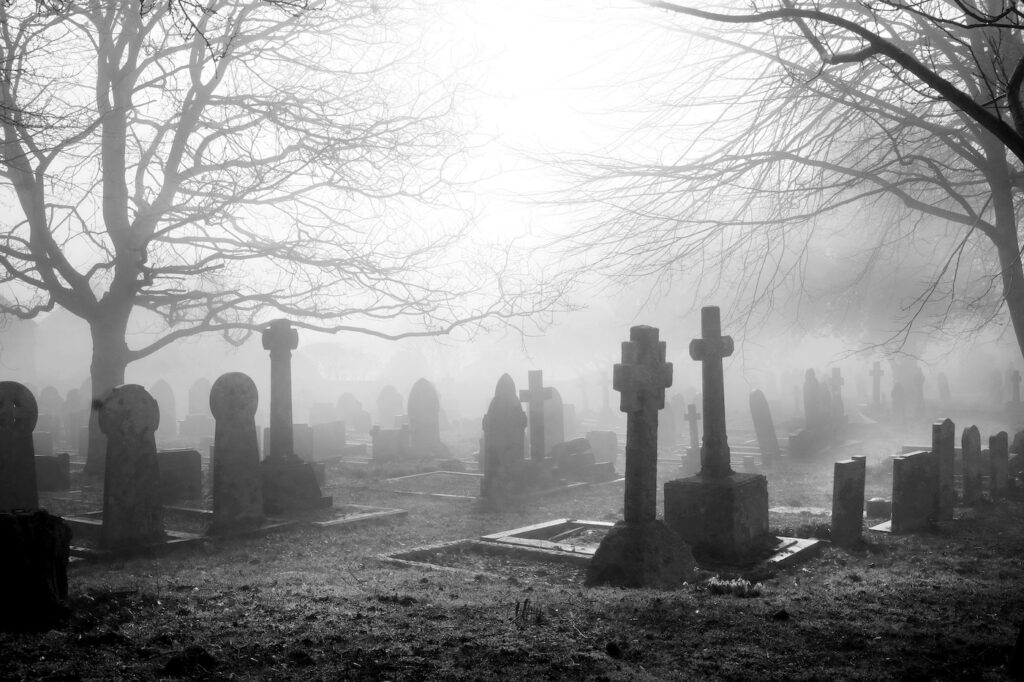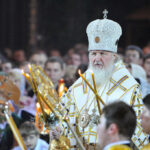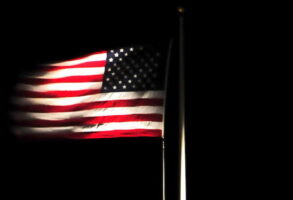
Published March 8, 2023
Georges Bernanos, the great French writer, had a particular distaste for the cult of optimism, especially its American variety. The idea that things somehow, naturally, turn out for the better struck him as laughably deluded, a form of “whistling past the graveyard.” In the real world, things often don’t turn out for the better. They get worse. And the graveyard can’t be ignored away, because death is real. We all sooner or later face it, and no amount of whistling will help us sneak past it. So how a culture deals with death speaks volumes about its mental health—and its understanding of who and what a human being is.
I turned 70 four years ago. Shortly thereafter I informed my family that I’ll be very displeased, despite being dead, if the priest at my funeral wears anything but black. They weren’t surprised. In the Catholic tradition, liturgical vestments have a catechetical role. They give meaning to the moment. Green is for Ordinary Time and the virtue of hope. Red is for Pentecost, the fire of the Holy Spirit, and the blood of martyrs. White, and occasionally gold, reflect the glory of the Christmas and Easter seasons, solemnities, and the great feasts. Purple is penitential for Lent and anticipative for Advent, and the color rose—hinting at the joy to come—is used on Advent’s Gaudete and Lent’s Laetare Sundays.
This “curriculum of color” in Catholic worship, like the annual progress of the Church calendar, has always made deep sense to me, mirroring the course of life itself. What doesn’t make sense is the absence of black today at exactly the emotional and religious event that most profoundly needs it. Since Vatican II, most Catholic funerals have been celebrated with white vestments, or the alternative, purple. Black vestments are still a legitimate option, but—at least in the United States, where optimists are (or until recently, were) the dominant sect—they’re rarely used. Many parishes no longer have them.
This is instructive. The reasoning for black’s exile goes something like this: white encourages trust in God’s love and mercy for the deceased. Purple communicates grief, but not fear. Black, on the other hand, is a downer; a hammer that drives home the nail of loss. And yet, ironically, this also makes it the sanest, most powerful, of funeral colors. It acknowledges the pain of mourning as necessary to healing, and it implicitly reminds us that an immediate, happy eternity is in nobody’s automatic “win” column. If white implies a freeway diamond lane past any afterlife unpleasantness, black reminds us that many of us will be stuck in traffic. Some of us for a long time—or worse. Which suggests two important facts: that the deceased needs our prayers, and that our own lives, and their content, will be judged in due course by a God who is not only merciful, but also just.
Most Catholics and other Christians will understand the argument I’ve just made, even if they disagree with the particulars. Death is a universal fact of life, but as Charles Chaput, borrowing from the philosopher Hans Jonas, noted some years ago, man is the only creature, among all living things, that knows he must die: “No other species buries or remembers its dead as we do. The grave is a uniquely human fact. It reminds us that we’re not like other animals. Thus, repudiating the grave implicitly denies our distinctive humanity by denying one of its most important markers.”
Death has emotional “weight” because every human life is woven into a fabric of other conscious, intentional lives and loves. The loss of the individual matters to those others in a singular way. Death also has a sacred aura because, for the religious believer, each human life is unique and unrepeatable, with a God-given dignity. And the human body, especially for Christians, is not an irrelevant husk of the departed soul. It’s an essential element of his or her personhood, destined to one day rise again. Funeral liturgies are thus as much for the living as they are for the dead. They remind us of the type of creature we are; that life has purpose; and that the grave is not the end. As Jonas wrote, “metaphysics arises from graves.” Or to put it another way: the grave anchors us to reality; the reality of loss in this world, and the reality—or at least the promise—of unending life in the next.
Death in a Secular Age
Now having said all of the above, consider the following.
The country I grew up in no longer exists. The late Paul Johnson said that America was born Protestant. And while scores of millions of us still practice some form of a biblical faith, it’s more accurate to say that America was born from a marriage of Bible-based belief and Enlightenment thought. Mixed marriages can survive and thrive, and many do—but only if the partners are truly compatible, and stay that way. The original brand of American Christianity was rigorously Calvinist. As the philosopher George Parkin Grant argued in Technology and Empire, the nature of Calvinist theology “made it immensely open [to] empiricism and utilitarianism,” resulting in a religion of material progress marked by “practical optimism” and “discarded awe.” Translation: we’re a pragmatic people. We’re addicted to technological mastery. And our real faith—no matter how we label ourselves—is a practical agnosticism focused radically on this world. In effect, we’re becoming the most thoroughly materialist culture in history.
This has shaped American attitudes toward death in different ways. Serving the needs of the deceased, and surviving family members, with compassion and dignity is a noble vocation. For Christians, it’s one of the seven “corporal works of mercy.” But it can also be a lucrative line of work, because there’s no lack of customers. Jessica Mitford’s 1963 book, The American Way of Death, attacked the funeral industry of her day for its greed and phony piety. Terry Southern did the same in The Loved One, a fiercely satirical 1965 film based on the Evelyn Waugh novel.
But that was then. Feelings toward death today reflect the more secularized, irreligious nature of the country. High-end caskets have lost some of their luster. Cremation is common. The afterlife is often viewed as a fantasy, or a guaranteed Happy Place with furniture provided by a person’s private beliefs.
Some grieving survivors have taken to scattering the ashes of a deceased loved one in a place of special meaning. In an age when green is especially good, and environmentalism can verge on the cultic, “human composting” is increasingly available. After all, why not feed Mother Nature with the rich nutrients of your decomposing corpse? And it’s attractively priced: currently at $5,500 or less. But these low-tech approaches have an unsatisfying, romantic-theatrical feel to them. The real experts know, or think they know, that the best way to deal with death is to simply kill it.
Denying Death
Futurists like Ray Kurzweil claim that we’re just a few scientific steps away from achieving immortality. The biotech company Calico Life Sciences focuses on extending human longevity and defeating age-related disease. Other research seeks to copy a person’s identity via memory chip, and then transfer it to new bodies as old ones wear out. The Cryonics Institute offers prompt cryogenic suspension and long-term storage for victims of terminal illness. For the low, low, price of $28,000, a person can be frozen in the hope that, in the future, he or she can be revived and healed with new nano-technologies. Other companies offer similar cryo-options at price tags up to $200,000, with an economy version for the head only. And yet Leon Kass, the great Jewish bioethicist, has repeatedly asked the essential question: why would any sane person want to live another century, or five, or forever in this world, even under the best circumstances?
Survival is an end in itself only in the short term. An endless life of consuming and digesting successive experiences isn’t a “human” life at all. We have an instinctive hunger for higher meaning; for a shared purpose beyond ourselves. Without it, even cocooned in luxury, even with our senses anesthetized by noise and distractions, we end in despair. Yet this is exactly what American culture now breeds, which is why our rates of depression, mental illness, and drug use continue to climb. Even suicide can seem to make terrifying sense. Why stick around if this is all there is? Scattering ashes, human composting, radical longevity extension, cryogenic suspension: these all, in their own odd ways, involve a kind of self-delusion that masks unacknowledged, unhealable emptiness. They’re blind to what death at the end of a good life, well lived, actually is: the doorway to something greater.
In his letters, J. R. R. Tolkien wrote that the real theme of Lord of the Rings is death and immortality; that attempts to artificially prolong life in this world are a trick of the Evil One; that we’re made for another home; and that one of God’s great gifts to men “is mortality; freedom from the circles of the world.” Simply put: we’re more than clever primates with a gift for telling tall tales about some Sugar Candy Mountain in an afterlife. One of the tales is true.
I suppose what I’m saying here is simply this: all those we love, and we ourselves, will one day go through that great black door of death. We need to acknowledge that fact and not try to evade or soften it. Without God, life really is a tragedy, and our mourning is a meaningless biochemical reaction. But our story doesn’t end there. The door has another side: a side of light, with a waiting, loving God. That’s why I can write these thoughts and sleep very well tonight—although I do hope that if my pastor ever reads this, he’ll buy some black vestments. I’ll gladly kick in on the cost. Because black is beautiful.
Francis X. Maier is a senior fellow with the Ethics and Public Policy Center.
Francis X. Maier is a Senior Fellow in the Catholic Studies Program at the Ethics and Public Policy Center. Mr. Maier’s work focuses on the intersection of Christian faith, culture, and public life, with special attention to lay formation and action.











